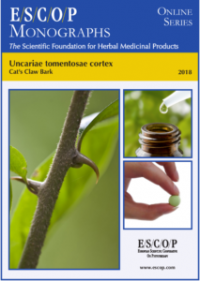
ESCOP monographs The Scientific Foundation for Herbal Medicinal Products. Online series. Uncariae tomentosae cortex (Cat’s Claw Bark). Exeter: ESCOP; 2018.
Uncariae tomentosae cortex
Cat’s Claw Bark
Uncaria tomentosa (Willd. ex Roem. et Schult.) DC.
Descargar la monografía (15¤ para el público en general, 12¤ para los socios de SEFIT)
Visualizar las monografías de ESCOP (30¤/año, gratis para los socios de SEFIT)
SUMMARY
The herbal monograph selects and summarises scientific studies and
textbooks regarding efficacy, dosage and safety to support the
therapeutic uses of cat’s claw bark.
This herbal drug by definition consists of the inner stem bark of Uncaria tomentosa (Willd. ex Roem. et Schult.) DC.
Studies with its main characteristic constituents oxindole alkaloids,
quinovic acid glycosides, polyphenols and procyanidins are included.
The therapeutic indication is as adjuvant for the treatment of mild inflammatory conditions.
Administration of cat’s claw bark addresses posology; its
duration of use; contra-indications; special warnings; special
precautions for use; interactions with other medicinal products; other
forms of interaction; in pregnancy and lactation; its effects on ability
to drive; undesirable effects; overdose.
In vitro experiments with cat’s claw bark demonstrated
anti-inflammatory, antiviral, antioxidant, anti-proliferative and
cytotoxic effects as well as effects on immune functions.
In vivo experiments with cat’s claw bark or its extracts in
animals demonstrated anti-proliferative, cytotoxic, reno-protective and
antimutagenic effects and effects on CNS and immune functions.
Pharmacological studies in humans concern persistent response to pneumococcal vaccine and antimutagenic activities.
Controlled clinical studies with cat’s claw bark in humans
demonstrated its use for reducing side effects of chemotherapy in
patients with breast cancer and improving life quality, social
functioning and fatigue in terminal cancer patients without further
medical treatment.
Preclinical safety data were assessed in toxicity studies. Safety data were assessed in human studies.
No adverse events, except possibly gastritis, could be clearly attributed to cat’s claw bark.
The selection of literature cited in the monograph is aimed at bringing
together relevant information about the possible physiological roles of
cat’s claw bark and its major constituents.
KEYWORDS
- Uncariae tomentosae cortex
- Cat’s Claw Bark
- Uncaria tomentosa (Willd. ex Roem. et Schult.) DC
- Mild inflammatory conditions



